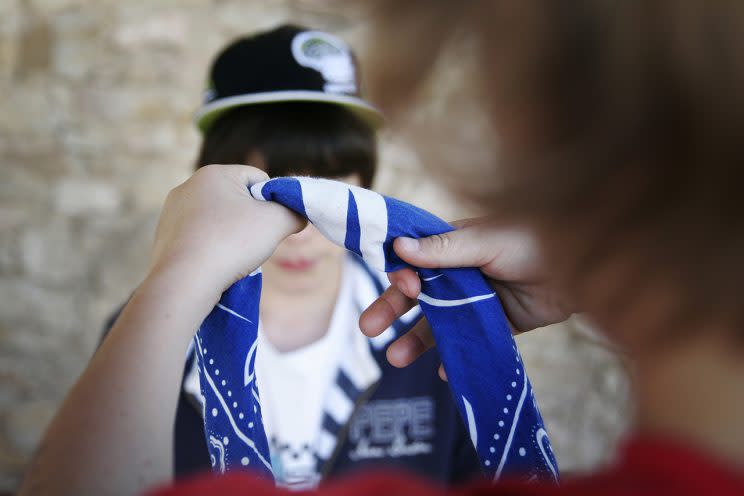What Parents Need to Know About the ‘Choking Game’

A New Jersey high school student has died as a result of taking part in the risky “choking game,” according a letter sent home to parents on Wednesday.
The Ridge High School student’s death was “one of the tragic losses of student life we have experienced this year,” said Nick Markarian, the superintendent of the Bernards Township school system, according to MyCentralJersey.com.
The student has not yet been identified. But while the Centers for Disease Control and Prevention has not updated its statistics on choking game-related deaths since between 1995 and 2007, when 82 such deaths were reported, recent stories about similar losses have come from districts in Maryland and South Carolina.
The choking game — also called “the fainting game,” “space monkey,” “flatliner,” “blackout,” and “the knockout challenge,” among other nicknames — is a dangerous adolescent pastime that has been around for decades and resurfaced again in recent years.
To “play,” you use hands or a homemade noose to choke a friend (or, more and more often, oneself) just enough to cut off the airway, until the person feels a quick, euphoric rush — which occurs because of hypoxia, or lack of oxygen to the brain. The catch is that sometimes the person who is choked will pass out or be left with irreversible brain damage — and sometimes, such with the teen in New Jersey, they can even die.
That grim reality is the reason some school districts, including those in Utah, California, and West Virginia, have begun to teach choking-game awareness as part of their health curriculums.
Utah’s Iron County School District, for example, started teaching students about the dangers of the game in 2014, after it left four students dead in just three years. “That data is too compelling to ignore,” Jennifer Wood, the district’s director of secondary education alternative programs, told Yahoo at the time. “It’s amazing how many have played the game or know others who have. It goes back decades.”
Much of the country’s growing awareness can be credited to Judy Rogg, of Santa Monica, Calif., who learned about the choking game in the worst possible way: Her son Erik died as a result of it at the age of 12 in 2010. She has since founded the national organization Erik’s Cause, and has teamed up with experts and researchers to continue her mission to educate the public about the dangers of the choking game.
“The common barrier you find at most schools is the notion that if we teach it, they’ll do it,” Rogg, who says she has been in touch with the parents of the New Jersey student who recently died, tells Yahoo Beauty. This idea echoes the objection often raised by those opposed to teaching kids about sex or drugs.
“Also, there is fear on the part of school districts, because this is a subject that they have not tackled before. They don’t realize just how much access kids have to ‘how to play’ videos that make it appear like harmless fun,” she says, adding that the organization’s training program for schools is simple and effective, and offers kids skills and solutions. “And the proof is in the pudding: After being taught now in Iron County for three years, it’s been making a tremendous difference in the community,” Rogg says. “Every parent, educator, and medical or mental health professional should read [the group’s thorough explainer and rationale for education] Data Drives a Compelling Narrative to really understand the scope of the problem and the results of our solution.”
Studies show that 75 percent of kids surveyed have heard of some form of pass-out games, Rogg’s site notes, and 20 to 32 percent of kids admit to having played them. Still, 82 percent of those who have participated report they were unaware of any dangers associated with it.
Experts say that accidental deaths from the choking game can often appear to suicides, and therefore are difficult to document.
In his letter to parents, Markarian, the New Jersey superintendent, said, “The early-adolescent brain does not process information in the same manner as an adult brain, and so children in this age group are not able to fully understand the serious consequences.”
Among the signs that someone is experimenting with the behavior are bloodshot eyes, broken blood vessels on the face or eyelids, mood swings, disorientation after being left alone, frequent and occasionally severe headaches, and bruises or marks around the neck, Markarian said.
Parents should also look for other evidence, such as knots in neckties, and belts, ropes, or plastic bags left in bedrooms, he said.
On the Erik’s Cause website, Rogg offers a sobering warning for other parents. “Erik was a normal, active, bright and curious 6th grader — an A student, Boy Scout, and athlete, who had focused plans and dreams for his future. He learned about this from a schoolmate the day before he tried it at home and died,” she writes. “There were no warning signs because he had only just learned of it. Had we known about its dangers, we would have discussed it, and I am confident that he never would have attempted to ‘play’ it … he would be alive today.”
Read more from Yahoo Beauty + Style:
Follow us on Instagram, Facebook, and Pinterest for nonstop inspiration delivered fresh to your feed, every day. For Twitter updates, follow @YahooStyle and @YahooBeauty.

